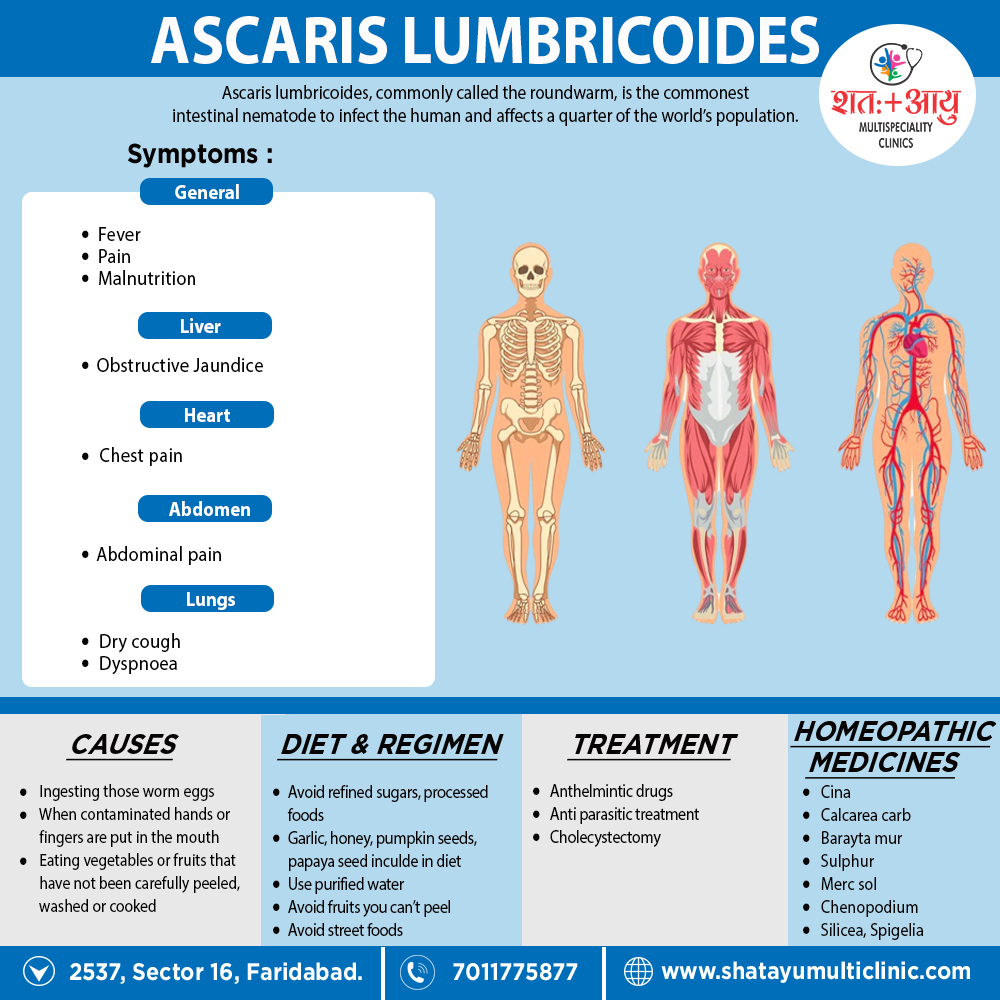Homeopathic Treatment of Ascaris lumbricoides (Roundworm)
Homeopathy treats the person as a whole. It means that homeopathic treatment focuses on the patient as a person, as well as his pathological condition. The homeopathic medicines selected after a full individualizing examination and case-analysis.
which includes
- The medical history of the patient,
- Physical and mental constitution,
- Family history,
- Presenting symptoms,
- Underlying pathology,
- Possible causative factors etc.
A miasmatic tendency (predisposition/susceptibility) also often taken into account for the treatment of chronic conditions.
What Homoeopathic doctors do?
A homeopathy doctor tries to treat more than just the presenting symptoms. The focus is usually on what caused the disease condition? Why ‘this patient’ is sick ‘this way’?.
The disease diagnosis is important but in homeopathy, the cause of disease not just probed to the level of bacteria and viruses. Other factors like mental, emotional and physical stress that could predispose a person to illness also looked for. No a days, even modern medicine also considers a large number of diseases as psychosomatic. The correct homeopathy remedy tries to correct this disease predisposition.
The focus is not on curing the disease but to cure the person who is sick, to restore the health. If a disease pathology not very advanced, homeopathy remedies do give a hope for cure but even in incurable cases, the quality of life can greatly improved with homeopathic medicines.
Homeopathic Medicines for Ascaris lumbricoides (Roundworm) :
The homeopathic remedies (medicines) given below indicate the therapeutic affinity but this is not a complete and definite guide to the homeopathy treatment of this condition. The symptoms listed against each homeopathic remedy may not be directly related to this disease because in homeopathy general symptoms and constitutional indications also taken into account for selecting a remedy.
Medicines for Ascaris lumbricoides (Roundworm):
Cina:
- Restless sleep, with rolling of eyes, dark rings around eyes; squinting; enlarged pupils.
- Constant rubbing the nose; epistaxis grinding also gnashing of teeth; face ale and cold, or red and hot.
- Loathing of food, or great hunger; nausea, vomiting; additionally, pain in umbilical region.
- Abdomen hard and distend; constipation.
- Dry, hacking cough at night; feverishness; convulsive motions of head and limbs; itching of anus from pinworms.[7]
Calcarea Carb:
- Headache, dark rings around the eyes, pale, bloated face; thirst.
- Thick, bloated belly; aching about the navel; diarrhoea.
- Easy perspiration from motion, scrofulosis.
- Tapeworm after Graph; Roundworm, with hard stool; crawling in rectum, as from worms, itching at anus, as from pinworms.[7]
Barayta Mur:
- Specifically for Worm affections; foetid breath; pain in region of navel.
- Aggravation in morning; dry cough; great appetite.
- Slimy, coated tongue, bloated abdomen.
- Periodical attacks of convulsions, which shake the whole body.
- Chronic, painless diarrhoea, yellow, slimy stools, vomiting exhaustion.[7]
Sulphur:
- Creeping in nose, creeping and biting in rectum, especially when passage of Roundworm and taenia.
- Nausea before meals also faintness after dinner.
- Restlessness at night.[7]
Merc Sol:
- Continuous greediness for eating, and still becomes steadily weaker.
- Foetid breath; itching of anus; inflammation of vulva; seat and round worms.[7]
Chenopodium:
- Worm affections; constipation, ineffectual urging with pressure on bladder and rectum.
- Moreover, Frequent cutting pains in abdomen, especially at night.
- Flatulency and urging to stool.
- Either Pale or yellowish Color of face.
- Scraping and burning in throat.
- Besides this Secretion of frothy mucus from mouth and throat; dullness in head.[7]
Silicea:
- Worm colic, with constipation or difficult stool.
- Yellow hands, blue nails.
- Reddish, bloody stools; flatulence, much rumbling.[7]
Spigelia:
- Nausea every morning before breakfast always better after breakfast.
- Dilated pupils, squinting; pale face; smarting in nose.
- Sensation of a worm rising in throat, better after eating.
- Vomiting of all she takes, with sour rising like vinegar from stomach; pain in bowels.
- Dry, hard cough at night, palpitation of heart.[7]

